Related Research Articles

Colonel H. H. Shri Sir Ranjitsinhji Vibhaji II,Jam Saheb of Nawanagar,,often known as Ranji or K. S. Ranjitsinhji,was the ruler of the Indian princely state of Nawanagar from 1907 to 1933,as Maharaja Jam Saheb,and a noted Test cricketer who played for the English cricket team. He also played first-class cricket for Cambridge University,and county cricket for Sussex. He is widely known as the "Father of Indian Cricket",as he was one of the earliest top-class Indian cricketers to play the sport.
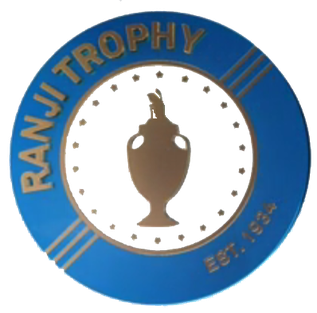
The Ranji Trophy is the premier domestic first-class cricket championship played in India. The Board of Control for Cricket in India annually organise it. The teams representing regional and state cricket associations participate. BCCI founded the championship in year 1934,since then it is annually organised across various grounds and stadiums in India.

Kumar Shri Duleepsinhji was a cricketer who played for England. Playing in the era before the Indian cricket team,he is considered one of India's first great batsmen,alongside his uncle Ranjitsinhji,who also represented England. Born in present-day Gujarat,he was educated at the Rajkumar College,Rajkot,before moving to England as a boy,where he attended Cheltenham College,and Cambridge University. The Duleep Trophy,long one of the premier competitions in Indian first class cricket,is named after him.

Nawanagar was an Indian princely state in the historical Halar region,located on the southern shores of the Gulf of Kutch. It was ruled by the Jadeja Rajput dynasty and became the part of newly formed India. The city is now known as Jamnagar. It had an area of 3,791 square miles (9,820 km2) and a population estimated at 336,779 in 1901. Its rulers,who use the title of "Jam Saheb" are of the same clan as the Rao of Kutch. They were entitled to a 13-gun salute. The state flag was a rectangular red flag with a white elephant,near and facing the hoist. During the British,the state was part of the Kathiawar Agency,within the Gujarat Division of Bombay Presidency.
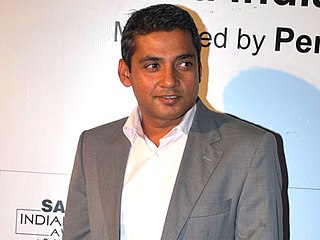
Ajaysinhji Jadeja,known as Ajay Jadeja,is an Indian former professional cricketer,who was a regular member of the Indian cricket team between 1992 and 2000. He played 15 Test matches and 196 One Day Internationals for India. He also captained Indian Cricket Team.

Jadeja is a Rajput clan that inhabits the Indian state of Gujarat. They originated from pastoral communities and laid a claim on the Rajput identity after marriages with Sodha Rajput women by adopting a process called Rajputisation.
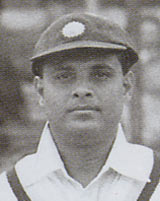
Sarobindu Nath"Shute" Banerjee was a cricketer who represented India in one official and five unofficial Test matches. He was right-arm medium pace bowler and a lower order batsman.
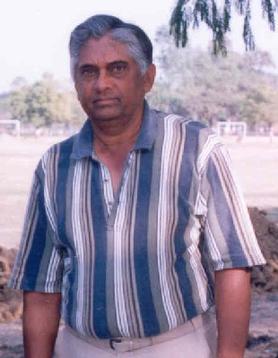
Hanumant Singh ( )(29 March 1939 –29 November 2006) was an Indian cricketer. He played in 14 Test matches for the Indian cricket team from 1964 to 1969. He was later an International Cricket Council match referee in 9 Tests and 54 One Day Internationals from 1995 and 2002.
Kumar Shri Indrajitsinhji Madhavsinhji was an Indian cricketer who played in four Test matches from 1964 to 1969 as a wicketkeeper-batsman.
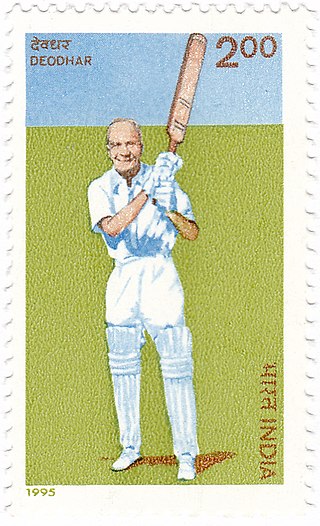
Dinkar Balwant Deodhar was an Indian cricketer. He played first-class cricket from 1911 to 1948.
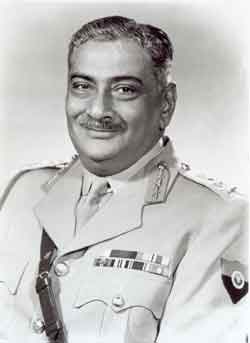
General Maharaj Shri Rajendrasinhji Jadeja,also known as K.S. Rajendrasinhji, was the first Chief of Army Staff of the Indian army,and the second Indian,after Field Marshal K. M. Cariappa,to become Commander-in-Chief of the Indian Army.

Kumar Shri Ghanshyamsinhji Daulatsinhji Jhala of Limbdi,often known as K. S. Limbdi during his cricket career,was an Indian nobleman and first-class cricketer. He was a cousin of England Test batsman Kumar Shri Duleepsinhji and brother-in-law of Natwarsinhji Bhavsinhji,the Jethwa ruler of the Princely State of Porbandar.
This article describes the history of cricket in British India from the 1918–19 season until the end of the Second World War in 1945.

Sir Digvijaysinhji Ranjitsinhji Jadeja was the Maharaja Jam Sahib of Nawanagar from 1933 to 1966,succeeding his uncle,the famed cricketer Ranjitsinhji.
Alfred Graham Skinner was an English cricketer. Skinner was a right-handed batsman who bowled right-arm off break. He was born in Calcutta and educated at Oundle School in England.
H.H. Jamsaheb Shatrusalyasinhji Jadeja is a former first-class cricketer and the last person to hold the title of Maharaja of Nawanagar.
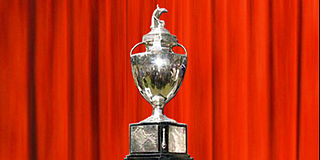
The 1936–37 Ranji Trophy was the third season of the Ranji Trophy. It was contested between 17 teams in a knockout format. Nawanagar won the title in their first appearance defeating Bengal in the final.
Rajkumar Shri Indravijaysinhji Dilawarsinhji Jadeja was an Indian cricketer. A descendant of the ruling family of Nawanagar State,and a nephew of Ranjitsinhji,who played Test cricket for England,Indravijaysinhji was introduced to cricket at the Rajkumar College,Rajkot where most of his family had been educated. He went on to play Ranji Trophy matches for Western India,Nawanagar,and Saurashtra,captaining Nawanagar. He also appeared for several combined teams against touring international sides,and finished his career with 28 first-class matches and a single first-class century.
Rajkumar Shri Sukhdevsinhji Rajendrasinhji Jadeja,known professionally as R. K. Sukhdevsinhji,is an Indian businessman and former cricketer. Sukhdevsinhji played a single first-class match for Baroda during the 1953–54 season,aged 17. His father,General Rajendrasinhji,was descended from the ruling family of Nawanagar State,and many other members of his family played cricket at high levels. Sukhdevsinhji later studied economics at St. Stephen's College,Delhi,and has held a variety of positions with companies in India's oil and gas sector,most notably as chairman of Bharat Petroleum.
Abdul Aziz Durrani was an Afghan-born Indian cricket coach and first-class cricketer. He played as a wicket-keeper and batsman for Sind and Nawanagar in the Ranji Trophy. He was the father of India Test cricketer Salim Durani.
References
- ↑ Miscellaneous matches played by Himmatsinhji (12) – CricketArchive. Retrieved 24 September 2014.
- ↑ Malvern College v Cheltenham College, Other matches in England 1916 – CricketArchive. Retrieved 24 September 2014.
- ↑ Royal Horse Artillery Cadets (St John's Wood) v Public Schools, Other matches in England 1916 – CricketArchive. Retrieved 24 September 2014.
- ↑ Australian XI v Indian Gymkhana, Other matches in England 1917 – CricketArchive. Retrieved 24 September 2014.
- 1 2 First-class matches played by Himmatsinhji (5) – CricketArchive. Retrieved 24 September 2014.
- ↑ Roshanara Club v Viceroy's XI, Other First-Class matches in India 1931/32 – CricketArchive. Retrieved 24 September 2014.
- ↑ Ranji Trophy matches played by Himmatsinhji (2) – CricketArchive. Retrieved 24 September 2014.
- ↑ Rajputana v Central India, Ranji Trophy 1936/37 (East Zone) – CricketArchive. Retrieved 24 September 2014.
- ↑ Central India v Rajputana, Ranji Trophy 1937/38 (East Zone) – CricketArchive. Retrieved 24 September 2014.
- ↑ Wild, Roland (1934). The Biography of Colonel His Highness Shri Sir Ranjitsinhji Vibhaji, Maharaja Jam Saheb of Nawanagar, G.C.S.I., G.B.E., K.C.I.E. London: Rich & Cowan Ltd. p. 181.
- ↑ "No. 32722". The London Gazette . 23 June 1922. p. 4728.
- ↑ "No. 32665". The London Gazette . 7 April 1922. p. 2819.
- ↑ "No. 33031". The London Gazette . 20 March 1925. p. 1958.
- ↑ Wild 1934, p. 261
- ↑ Wild 1934, p. 288
- ↑ "No. 33744". The London Gazette . 14 August 1931. p. 5335.
- ↑ Wild 1934, p. 312
- ↑ "No. 37407". The London Gazette . 28 December 1945. p. 12.
- ↑ — (15 February 1952). "New Lieutenant-Governors" – The Hindu . Retrieved 24 September 2014.
- ↑ Inder Malhotra (14 December 2007). "Antony’s sudden awakening: appalling management of China border" – The Tribune . Retrieved 24 September 2014.
- ↑ "Obituary Reference" (PDF). Lok Sabha Debates. 23 (1): 26. 19 February 1973. Retrieved 7 October 2020.